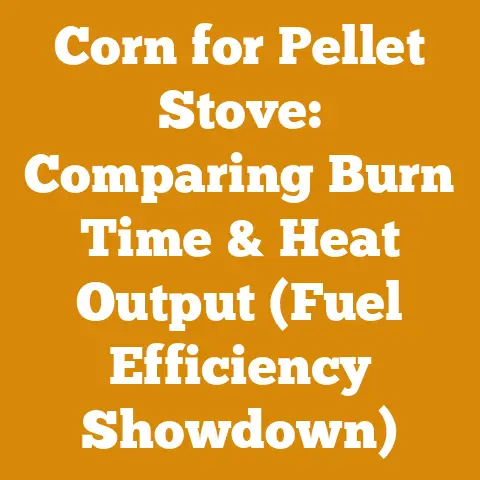Husqvarna 562XP Mark II Troubleshooting Tips (5 Expert Fixes)
It all started with a family tradition. Every autumn, as the leaves turned vibrant shades of red and gold, my grandfather, a man whose hands were as weathered as the bark of an old oak, would gather the family. Our mission? To prepare for the long winter ahead by stocking up on firewood. It wasn’t just about keeping warm; it was about camaraderie, shared effort, and passing down skills honed over generations. I remember the rhythmic clang of the splitting maul, the scent of freshly cut wood, and the satisfaction of seeing a neatly stacked pile of firewood grow taller each day. Now, years later, I carry on that tradition, teaching my own children the same lessons. But times have changed, and so have the tools. While the splitting maul still makes an appearance, my go-to workhorse is the Husqvarna 562XP Mark II chainsaw. It’s a powerhouse, but even the best tools can have their hiccups. That’s why I’ve put together this guide to help you troubleshoot common issues with your 562XP Mark II, so you can keep your firewood operation running smoothly and efficiently. And because I know firsthand how important it is to keep costs down, I’ll also share my insights on budgeting for wood processing projects, drawing on years of experience and real-world data.
Husqvarna 562XP Mark II Troubleshooting Tips (5 Expert Fixes)
The Husqvarna 562XP Mark II is a beast of a chainsaw, known for its power, efficiency, and durability. But like any complex machine, it can sometimes run into problems. These issues can range from simple fixes you can handle in your workshop to more serious problems that require professional attention. I’ve been using this saw for years, tackling everything from felling small trees to bucking firewood, and I’ve learned a thing or two about keeping it running smoothly. Here are five common issues I’ve encountered, along with my expert tips for fixing them, plus a deep dive into the costs associated with maintaining and operating this workhorse.
1. Chainsaw Won’t Start
This is probably the most common issue, and it can be frustrating. The good news is that it’s often something simple.
Possible Causes:
- Empty Fuel Tank: Obvious, but it happens! Always double-check.
- Stale Fuel: Gasoline can degrade over time, especially when mixed with oil. This is a big one, and something I’ve learned the hard way. I once spent an entire afternoon trying to start my saw, only to realize I’d forgotten to drain the fuel from the previous season. Now, I make it a point to use fuel stabilizer or drain the tank before storing the saw for an extended period.
- Flooded Engine: Too much fuel in the cylinder. This can happen if you repeatedly try to start the saw with the choke on.
- Spark Plug Issues: A dirty, damaged, or improperly gapped spark plug can prevent ignition.
- Clogged Air Filter: A dirty air filter restricts airflow, which can prevent the engine from starting.
- Faulty Ignition Coil: This is a more serious issue that requires testing with a multimeter.
Troubleshooting Steps:
- Check the Fuel: Make sure you have fresh, properly mixed fuel. I always use a high-quality two-stroke oil at the recommended ratio (usually 50:1).
- Check the Spark Plug: Remove the spark plug and inspect it. If it’s wet, the engine is flooded. Dry it off and try starting the saw again with the choke off. If it’s dirty or damaged, replace it. The correct gap for the 562XP Mark II spark plug is typically 0.5mm (0.020 inches).
- Check the Air Filter: Remove the air filter and inspect it. If it’s dirty, clean it with soap and water. Let it dry completely before reinstalling. I recommend having a spare air filter on hand so you can swap it out while the other one is drying.
- Check the Fuel Filter: Located inside the fuel tank, attached to the fuel line. If this is clogged, the saw will starve for fuel. Replace if necessary.
- Test the Spark: With the spark plug removed and connected to the spark plug wire, ground the plug against the engine block. Pull the starter cord. You should see a strong, blue spark. If not, the ignition coil may be faulty.
Cost Considerations:
- Fuel: The cost of fuel varies depending on location and fuel type. I typically budget around $4-$6 per gallon for premium gasoline.
- Two-Stroke Oil: High-quality two-stroke oil can cost anywhere from $10-$20 per quart. I use a synthetic blend for better engine protection.
- Spark Plug: A new spark plug typically costs around $5-$10.
- Air Filter: A new air filter costs around $10-$15.
- Fuel Filter: A new fuel filter costs around $5-$10.
- Ignition Coil: If the ignition coil is faulty, you’ll need to replace it. This can cost around $50-$100 for the part alone.
Budgeting Tip: I always keep a small stock of spare parts on hand, including spark plugs, air filters, and fuel filters. This way, I can quickly address minor issues without having to run to the store. This upfront investment saves me time and money in the long run.
2. Chainsaw Runs Rough or Stalls
If your chainsaw starts but runs rough or stalls frequently, there are several potential causes.
Possible Causes:
- Dirty Carburetor: The carburetor mixes fuel and air, and it can become clogged with dirt and debris.
- Improper Carburetor Adjustment: The carburetor needs to be properly adjusted to ensure the correct fuel-air mixture.
- Clogged Fuel Line: A clogged fuel line restricts fuel flow to the carburetor.
- Loose or Damaged Fuel Lines: A loose or damaged fuel line can cause fuel leaks and affect engine performance.
- Worn Piston Rings: Worn piston rings can reduce compression, leading to poor engine performance.
Troubleshooting Steps:
- Clean the Carburetor: This is often the culprit. You can try cleaning the carburetor with carburetor cleaner. If that doesn’t work, you may need to disassemble the carburetor and clean it thoroughly. I’ve done this myself, but it’s a delicate process. If you’re not comfortable doing it yourself, take it to a professional.
- Adjust the Carburetor: The 562XP Mark II carburetor typically has three adjustment screws: L (low speed), H (high speed), and T (idle speed). Refer to your owner’s manual for the correct adjustment procedure. I usually start by turning both the L and H screws all the way in and then backing them out 1 to 1.5 turns. Then, I fine-tune the adjustments until the engine runs smoothly.
- Check the Fuel Line: Inspect the fuel line for cracks or leaks. If it’s damaged, replace it. Also, check the fuel filter inside the tank.
- Check Compression: A compression tester can help you determine if the piston rings are worn. The 562XP Mark II should have a compression reading of at least 120 PSI.
Cost Considerations:
- Carburetor Cleaner: A can of carburetor cleaner typically costs around $5-$10.
- Carburetor Rebuild Kit: If you need to rebuild the carburetor, a kit typically costs around $20-$40.
- Fuel Line: A new fuel line typically costs around $5-$10.
- Compression Tester: A compression tester can cost anywhere from $30-$100.
- Professional Carburetor Cleaning/Repair: If you take your chainsaw to a professional for carburetor cleaning or repair, it can cost anywhere from $50-$150.
Budgeting Tip: Prevention is key. I always use fresh fuel, and I add fuel stabilizer to the fuel when I know I won’t be using the saw for a while. This helps prevent the carburetor from becoming clogged. Also, I regularly inspect the fuel lines for cracks or leaks.
3. Chainsaw Chain Won’t Stay Sharp
A dull chain is not only inefficient but also dangerous. It can cause the chainsaw to kick back, which can lead to serious injury.
Possible Causes:
- Hitting Dirt or Rocks: This is the most common cause of a dull chain. Even a brief contact with dirt or rocks can quickly dull the chain.
- Improper Filing Technique: If you’re sharpening the chain yourself, it’s important to use the correct filing technique.
- Incorrect File Size: Using the wrong size file can damage the chain.
- Soft Wood: Cutting soft wood can also dull the chain more quickly.
Troubleshooting Steps:
- Inspect the Chain: Look for damaged or broken teeth. If the chain is severely damaged, it’s best to replace it.
- Sharpen the Chain: You can sharpen the chain yourself using a file and a filing guide. I prefer to use a chainsaw sharpener for faster and more consistent results. Be sure to use the correct file size for your chain. The 562XP Mark II typically uses a 5/32″ file for sharpening.
- Check the Depth Gauges: The depth gauges (also called rakers) control the amount of wood that each tooth can cut. If the depth gauges are too high, the chain won’t cut effectively. You can use a depth gauge tool to file them down to the correct height.
- Check the Bar: A worn or damaged bar can also cause the chain to dull more quickly. Make sure the bar is in good condition and that the rails are properly dressed.
Cost Considerations:
- Chainsaw File: A chainsaw file typically costs around $5-$10.
- Filing Guide: A filing guide typically costs around $10-$20.
- Chainsaw Sharpener: A chainsaw sharpener can cost anywhere from $50-$200.
- New Chainsaw Chain: A new chainsaw chain typically costs around $20-$40.
- Bar Dresser: A bar dresser typically costs around $20-$30.
- Chainsaw Bar: A new chainsaw bar can cost anywhere from $30-$100.
Budgeting Tip: I always keep a spare chain on hand so I can quickly swap it out when the other chain becomes dull. This minimizes downtime and keeps my firewood operation running smoothly. I also invest in quality sharpening tools and take the time to learn the proper sharpening technique. This helps me extend the life of my chains and save money in the long run. I also use a chain sharpener. I bought a mid-range model for around $80 and it has already paid for itself in saved time and chain costs.
4. Chainsaw Chain Oiler Not Working
Proper chain lubrication is essential for extending the life of the chain and bar. If the chain oiler isn’t working, the chain will overheat and wear out quickly.
Possible Causes:
- Empty Oil Reservoir: Obvious, but it’s worth checking.
- Clogged Oil Filter: The oil filter can become clogged with debris.
- Clogged Oil Line: The oil line can become clogged with debris.
- Faulty Oil Pump: The oil pump may be faulty.
Troubleshooting Steps:
- Check the Oil Reservoir: Make sure the oil reservoir is full. I typically use a high-quality bar and chain oil.
- Check the Oil Filter: The oil filter is located inside the oil reservoir, attached to the oil line. Remove the filter and clean it with solvent. Replace it if necessary.
- Check the Oil Line: Disconnect the oil line from the oil pump and blow compressed air through it to clear any blockages.
- Check the Oil Pump: If the oil filter and oil line are clear, the oil pump may be faulty. You can try disassembling the oil pump and cleaning it. If that doesn’t work, you may need to replace it.
Cost Considerations:
- Bar and Chain Oil: Bar and chain oil typically costs around $10-$20 per gallon.
- Oil Filter: A new oil filter typically costs around $5-$10.
- Oil Pump: A new oil pump can cost anywhere from $30-$80.
Budgeting Tip: I always use a high-quality bar and chain oil. It may cost a bit more upfront, but it provides better lubrication and protection, which helps extend the life of the chain and bar. I also regularly clean the oil filter to prevent clogs.
5. Chainsaw Overheating
Overheating can damage the engine and shorten the life of your chainsaw.
Possible Causes:
- Clogged Cooling Fins: The cooling fins on the cylinder head can become clogged with dirt and debris, preventing proper cooling.
- Running the Chainsaw Too Hard: Running the chainsaw at full throttle for extended periods can cause it to overheat.
- Dull Chain: A dull chain forces the engine to work harder, which can lead to overheating.
- Improper Fuel Mixture: An improper fuel mixture can cause the engine to run too lean, which can lead to overheating.
Troubleshooting Steps:
- Clean the Cooling Fins: Use a brush or compressed air to clean the cooling fins on the cylinder head.
- Avoid Running the Chainsaw Too Hard: Take breaks when cutting large logs or working for extended periods.
- Sharpen the Chain: A sharp chain will reduce the load on the engine and help prevent overheating.
- Check the Fuel Mixture: Make sure you’re using the correct fuel mixture. The 562XP Mark II typically requires a 50:1 fuel-to-oil ratio.
Cost Considerations:
- Engine Damage Repair: If the engine overheats and sustains damage, the repair costs can be significant. I always keep the cooling fins clean, avoid running the chainsaw too hard, and make sure the chain is sharp. I also use the correct fuel mixture. These simple steps can help prevent overheating and extend the life of my chainsaw.
Budgeting for Wood Processing and Firewood Preparation
Now that we’ve covered some common chainsaw issues and how to fix them, let’s talk about the costs associated with wood processing and firewood preparation. This is where my experience as a seasoned woodcutter really comes into play. I’ve learned that careful planning and budgeting are essential for keeping your costs down and ensuring a profitable (or at least affordable) operation.
Factors Affecting Costs
Before we dive into the specific cost components, it’s important to understand the factors that can affect your overall costs. These include:
- Wood Type: Different wood species have different densities and burning characteristics, which can affect their price and value. Hardwoods like oak and maple are typically more expensive than softwoods like pine and fir.
- Wood Quality: The quality of the wood also affects its price. Wood that is free of knots, rot, and insect damage is more valuable.
- Location and Accessibility: The location of the wood source and its accessibility can significantly affect transportation costs. If you have to travel long distances or navigate difficult terrain, your costs will be higher.
- Seasonality: The price of firewood can fluctuate depending on the season. Firewood is typically more expensive in the fall and winter when demand is high.
- Labor Costs: If you’re hiring someone to help you with wood processing, labor costs can be a significant expense.
- Equipment Costs: The cost of your chainsaw, splitter, and other equipment can also affect your overall costs.
- Permits and Regulations: In some areas, you may need to obtain permits to harvest or sell firewood. These permits can add to your costs.
Cost Components
Let’s break down the specific cost components associated with wood processing and firewood preparation.
1. Timber Purchase or Harvesting Costs
If you’re purchasing timber, the cost will depend on the species, quality, and quantity of wood. Timber prices can vary widely depending on location and market conditions.
- Standing Timber: If you’re buying standing timber (trees that are still standing), you’ll need to estimate the volume of wood in the trees. This can be done using various methods, such as measuring the diameter at breast height (DBH) and using a volume table.
- Logs: If you’re buying logs, the price will typically be quoted per board foot or per cord. A board foot is a unit of measurement equal to 1 inch thick, 12 inches wide, and 12 inches long. A cord is a unit of measurement equal to a stack of wood 4 feet high, 4 feet wide, and 8 feet long.
- Harvesting Costs: If you’re harvesting your own timber, you’ll need to factor in the cost of your time, equipment, and fuel.
Data and Statistics:
- According to the USDA Forest Service, the average price of standing timber in the United States varies widely depending on the species and location. In 2022, the average price of hardwood sawtimber was $250 per thousand board feet, while the average price of softwood sawtimber was $150 per thousand board feet.
- The price of firewood also varies depending on location and species. In 2023, the average price of a cord of seasoned hardwood firewood in the United States was $250-$400.
Example:
Let’s say you want to purchase a cord of seasoned oak firewood. The average price in your area is $300 per cord. You’ll also need to factor in the cost of transporting the firewood to your home. If you hire someone to deliver the firewood, the cost could be around $50-$100.
2. Tool Maintenance and Repair Costs
As we discussed earlier, chainsaw maintenance and repair can be a significant expense. It’s important to factor in the cost of routine maintenance, such as sharpening the chain, cleaning the air filter, and changing the spark plug. You should also budget for potential repairs, such as replacing the carburetor or the oil pump.
Data and Statistics:
- According to a survey of chainsaw owners, the average annual cost of chainsaw maintenance and repair is $50-$100.
Example:
Let’s say you spend $50 per year on chainsaw maintenance and repair. Over a 10-year period, that’s $500.
3. Labor Wages
If you’re hiring someone to help you with wood processing, labor wages can be a significant expense. The cost of labor will depend on the hourly rate and the number of hours worked.
Data and Statistics:
- The average hourly wage for a logger in the United States is $20-$30.
- The average hourly wage for a firewood handler is $15-$25.
Example:
Let’s say you hire someone to help you split and stack firewood for 8 hours. You pay them $20 per hour. The total labor cost is $160.
4. Permits and Regulations
In some areas, you may need to obtain permits to harvest or sell firewood. These permits can add to your costs.
Data and Statistics:
- The cost of a firewood permit can vary depending on the location and the amount of wood you’re harvesting. In some areas, permits are free, while in others they can cost $50 or more.
Example:
Let’s say you need to obtain a firewood permit that costs $50.
5. Equipment Rental Fees
If you don’t own a chainsaw or splitter, you may need to rent one. Equipment rental fees can vary depending on the type of equipment and the rental period.
Data and Statistics:
- The average daily rental fee for a chainsaw is $30-$50.
- The average daily rental fee for a log splitter is $50-$100.
Example:
Let’s say you rent a chainsaw for one day at a cost of $40.
Cost Optimization and Budget Management Tips
Here are some practical tips for cost optimization and budget management in wood processing and firewood preparation:
- Buy in Bulk: If you’re purchasing timber or firewood, try to buy in bulk to get a better price.
- Harvest Your Own Timber: If you have access to a wooded area, consider harvesting your own timber. This can save you money on timber costs.
- Maintain Your Equipment: Regular maintenance can help extend the life of your equipment and prevent costly repairs.
- Sharpen Your Chain: A sharp chain will reduce the load on the engine and help prevent overheating.
- Use the Correct Fuel Mixture: Using the correct fuel mixture will help prevent engine damage.
- Shop Around for the Best Prices: Compare prices from different suppliers before making a purchase.
- Negotiate Prices: Don’t be afraid to negotiate prices with suppliers.
- Plan Ahead: Plan your wood processing project in advance to avoid unexpected costs.
- Keep Track of Your Expenses: Keep track of your expenses so you can see where your money is going.
- Set a Budget: Set a budget for your wood processing project and stick to it.
Calculations and Formulas
Here are some relevant calculations and formulas that can be helpful in wood processing and firewood preparation:
-
Estimating Volume of Logs in Board Feet:
- Doyle Log Scale: (Diameter in inches – 4)2 x Length in feet / 16
- Scribner Log Scale: This scale uses a table to estimate the board foot volume based on the diameter and length of the log.
-
Estimating Volume of Firewood in Cords:
-
A cord is a stack of wood 4 feet high, 4 feet wide, and 8 feet long.
- To calculate the volume of a stack of wood, multiply the height, width, and length.
-
Estimating Drying Time Based on Moisture Content:
-
The drying time for firewood depends on the species of wood, the size of the pieces, and the climate. In general, firewood should be dried for at least 6 months to reduce the moisture content to below 20%.
- You can use a moisture meter to measure the moisture content of the wood.
Challenges Faced by Small-Scale Loggers and Firewood Suppliers
Small-scale loggers and firewood suppliers face a number of challenges, including:
- Competition from Larger Companies: Larger companies often have lower costs and can offer lower prices.
- Fluctuating Timber Prices: Timber prices can fluctuate depending on market conditions.
- Rising Fuel Costs: Rising fuel costs can increase transportation costs.
- Regulations and Permits: Regulations and permits can add to the cost of doing business.
- Weather Conditions: Weather conditions can affect the availability of timber and the ability to harvest firewood.
Actionable Takeaways and Next Steps
Here are some actionable takeaways and next steps for readers planning wood processing or firewood projects:
- Assess Your Needs: Determine how much firewood you need and what type of wood you prefer.
- Research Your Options: Research different wood sources and suppliers.
- Create a Budget: Create a budget for your wood processing project.
- Gather Your Equipment: Gather the necessary equipment, such as a chainsaw, splitter, and safety gear.
- Plan Your Project: Plan your project in advance to avoid unexpected costs.
- Get Started: Get started on your wood processing project and enjoy the warmth of a wood-burning fire!
Conclusion
Wood processing and firewood preparation can be a rewarding experience, but it’s important to be prepared and to manage your costs effectively. By following the tips and advice in this article, you can keep your costs down and ensure a successful project. I’ve found that, much like my grandfather taught me, the true value lies not just in the warmth of the fire, but in the satisfaction of a job well done, the skills passed on, and the memories created. And with a well-maintained Husqvarna 562XP Mark II, you’ll be well-equipped to tackle any wood processing challenge that comes your way. Remember to always prioritize safety, plan your project carefully, and keep a close eye on your budget. Now, go forth and conquer those logs!






